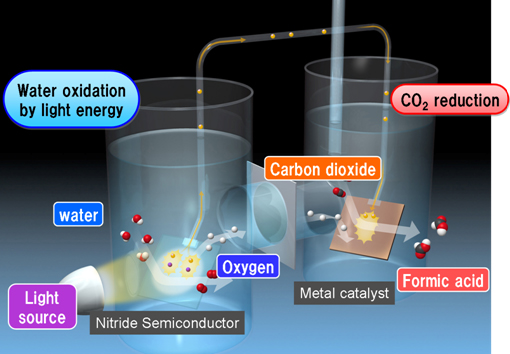

A group at Panasonic has developed the Artificial Photosynthesis System, which produces organic materials with a world-leading efficiency in terms of solar energy conversion. The recently achieved efficiency, 0.2%, is on a par with that for real plants used in biomass energy.
Artificial photosynthesis is a technology that uses sunlight to produce oxygen and organic substances from water and carbon dioxide, like plants do. As an ideal technology that could solve both global warming and energy issues, artificial photosynthesis is currently being researched worldwide.
“This device is a demonstration model of the artificial photosynthesis system we’ve developed. When light hits this electrode, a CO2 reduction reaction occurs. The place the reaction occurs is yellow now, but it gradually becomes green. This is the part where CO2 actually reacts, and the energy source is created.”
Here’s how the reaction works. First of all, the photo-electrode is filled with water and illuminated. The light is absorbed, and the water molecules react, producing electrons, oxygen molecules, and hydrogen ions. The electrons move through wires to a catalyst electrode, where they react with CO2 and hydrogen ions. This reduction reaction produces organic substances, mainly formic acid.
To convert CO2 in this way, electrons must be excited to a high-energy state using light. In the current system, Panasonic is using a nitride semiconductor, as in LED lamps, for the photo-electrode. In this way, Panasonic has discovered that electrons can be excited to the energy state required to react with CO2.
This is an experiment using sunlight. Even in tests using actual solar illumination, the movement of electrons due to the chemical reaction can be measured as a current between the electrodes.
In addition, by designing the material for the metal catalyst, it’s possible to vary the type of organic substances produced. At Panasonic’s lab, the latest machines have been introduced to analyze the substances.
“When carbon dioxide reacts, the organic substances produced are of various kinds. Currently, the main substance produced is formic acid, but in the future, we’d like to produce even more useful substances, such as hydrocarbons or alcohol. Until now, researchers have been doing lots of individual experiments to see what substances can be obtained with different catalysts in various environments. But with this device, we can do eight experiments at once, using different materials and reactions. So, we can do R&D more systematically, and with higher throughput.”
From now on, Panasonic aims to achieve an efficiency similar to that of plants in ethanol production. As a future prospect, the company wants to operate artificial photosynthesis plants, which could absorb CO2 from factories and produce ethanol.



